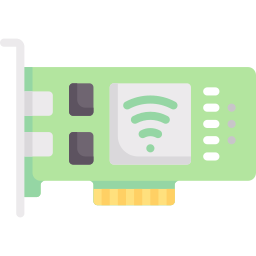
Network Interface Card (NIC) – An Essential Computer Hardware Component
A Network Interface Card (NIC) is a fundamental hardware component that enables a computer to connect and communicate with a network. It is either integrated into the motherboard or available as an expansion card that can be inserted into a slot on the computer's motherboard. NICs operate at the data link layer of the OSI model and play a key role in both wired and wireless networking. They are responsible for converting data from a format suitable for the computer into one that is suitable for transmission over a network, and vice versa.
Key Functions and Uses of a Network Interface Card (NIC)
Establishes a physical connection between a computer and a network, whether it be a local area network (LAN), wide area network (WAN), or the internet.
Converts digital data generated by the computer into electrical signals (in case of wired NICs) or radio signals (in case of wireless NICs), enabling data transmission over the network medium.
Receives incoming signals from the network and converts them back into digital data for processing by the computer.
Supports communication protocols such as Ethernet or Wi-Fi, allowing for standardized data exchange between network devices.
Assigns a unique MAC (Media Access Control) address to each device, which helps in identifying and managing devices within a network.
Manages error detection and data integrity, ensuring that the data being transmitted or received is accurate and complete.
Allows for full-duplex communication, enabling simultaneous data transmission and reception, which enhances network efficiency.
Facilitates remote communication, file sharing, internet access, printer sharing, and participation in network-based applications.
Types of Network Interface Cards
Wired NIC: Typically uses an Ethernet cable (such as Cat5e, Cat6) to connect to a network. Wired NICs offer stable and high-speed connections and are commonly used in desktops, servers, and business environments.
Wireless NIC: Uses radio waves to connect to a wireless access point. Wireless NICs are common in laptops, tablets, and mobile devices. They provide flexibility and mobility but may experience interference and variable speeds.
Fiber NIC: Used in environments that require extremely high-speed data transfer and long-distance communication. Fiber NICs are prevalent in data centers and enterprise-level infrastructure.
Availability and Cost Considerations
Most modern computers come with built-in NICs, making them a standard component with no additional cost to the user.
External NICs or upgraded NICs (e.g., 10Gbps Ethernet or advanced wireless cards) can be purchased separately depending on the required performance and compatibility.
The cost of an additional or higher-performance NIC can vary based on features such as data transfer speed, brand, and interface type. Basic wired NICs are generally inexpensive, while high-end or fiber NICs may be significantly more costly.
Using a NIC does not typically involve recurring fees. The cost is usually limited to the hardware purchase itself. Internet access or network usage fees are separate and are related to the service provider, not the NIC.
Comparison with Other Networking Hardware
NIC vs. Router: A NIC connects a single device to a network, while a router connects multiple devices and manages traffic between networks. The NIC is the endpoint interface, whereas the router serves as a central hub or gateway.
NIC vs. Switch: A NIC is installed on the device to enable connection, while a switch connects multiple NICs together within a network. A switch operates at a higher level to manage and direct data packets between devices.
NIC vs. Modem: The modem is used to connect a network to the internet via an ISP, converting digital data to analog signals and vice versa. The NIC connects a computer to a local network, allowing communication with other local or internet-connected devices.
Conclusion
The Network Interface Card is an indispensable component in modern computing environments. It acts as a bridge between a computer and the network infrastructure, ensuring smooth and efficient data communication. Whether for personal use, business operations, or data center connectivity, NICs provide the foundation for network access and digital interaction. While most users benefit from integrated NICs without incurring additional costs, high-performance or specialized applications may require purchasing advanced NICs. Understanding the role and types of NICs is essential for optimizing network performance, ensuring compatibility, and supporting the ever-increasing demands of digital connectivity.












